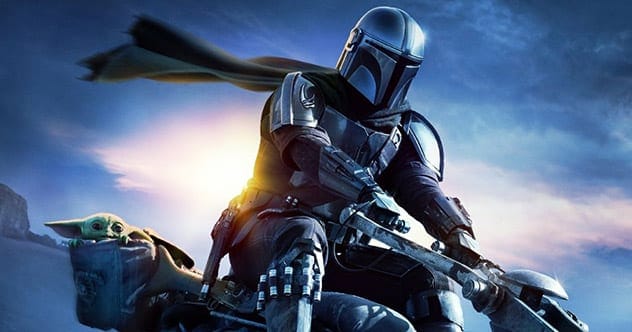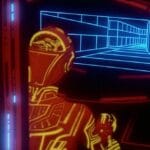The Mandalorian quickly became a cornerstone of Disney+, captivating audiences with its blend of classic Star Wars elements and fresh storytelling. The show masterfully weaves nostalgia with innovation, appealing to both longtime fans and newcomers alike. Set in a galaxy rich with history, The Mandalorian is packed with hidden details. Ready to dive in? Here are ten fascinating facts and Easter eggs you might have missed!
The Mos Eisley Bar Still Doesn’t Discriminate (Against Droids)
One of the most iconic scenes from the original Star Wars movie is Luke Skywalker’s visit to the bustling cantina in Mos Eisley. The gruff bartender, Wuher, famously shouts, “We don’t serve their kind here!” referring to C-3PO. Fast forward to The Mandalorian, and it seems the cantina has relaxed its anti-droid policy. Not only are droids allowed, but they’re also working behind the bar! Talk about inclusivity! Mando finds that the bartender droids are just as curt as their organic predecessor. Some things never change, even in the Outer Rim! Many of the shots approaching and entering the cantina are replicated from the original movie, visually highlighting how things have (or haven’t) evolved.
Sand People Communicate Via Sign Language
The Tusken Raiders have often been portrayed as savage beings, but The Mandalorian offers a more cultured perspective. In both “The Gunslinger” and “The Marshal,” the Tuskens communicate via sign language. To ensure accuracy, deaf actor Troy Kotsur was hired. Kotsur explained, “I did research on the culture and environment of Tusken Raiders […] my goal was to avoid ASL (American Sign Language). I made sure it became Tusken Sign Language based on their culture and environment.” This adds depth and understanding to a previously misunderstood group.
The Empire’s Dark Inspiration
Star Wars has always drawn from real-world history, and The Mandalorian is no exception. In “The Heiress,” an Imperial captain chooses suicide over capture by biting down on an electric shock component hidden in his mouth. This mirrors how high-ranking Nazi officials used cyanide capsules to avoid interrogation and imprisonment. It’s a dark reminder of the real-world inspirations behind the galaxy’s villains.
IG-11’s Heroic Sacrifice Remembered
In the Season 1 finale, IG-11 sacrifices himself to protect Grogu and save Nevarro. This heroic act wasn’t forgotten. When Mando returns in Season 2, eagle-eyed viewers might notice a statue erected in IG-11’s honor. It’s these small details that create continuity and resonate with the Star Wars community, showcasing that even droids can leave a lasting legacy.
Return of the Ice Cream Maker (Camtono)
One of the most beloved pieces of Star Wars trivia is the appearance of an ice cream maker during the evacuation of Cloud City in The Empire Strikes Back. This prop, known in-universe as a camtono, became a cult favorite. Jon Favreau revisited the camtono in The Mandalorian. In Chapter 1, the reward for capturing Grogu is a camtono full of Beskar. This inclusion delighted fans, solidifying the camtono’s place in Star Wars history.
The Krayt Dragon Finally Arrives
In “The Marshal,” Mando helps defeat a Krayt dragon terrorizing Mos Pelgo. While Krayt dragons have appeared in books and games, their appearance in The Mandalorian marks their first canonical, fully realized appearance. In the original Star Wars, C-3PO walks past the skeleton of one, and Obi-Wan Kenobi imitates its cry to scare away Tusken Raiders. Seeing the Krayt dragon in all its terrifying glory is a treat for longtime fans.
Jabba the Hutt’s Legacy Continues
The post-credits scene of “The Rescue” shows Boba Fett returning to Tatooine and confronting Bib Fortuna, Jabba the Hutt’s former major domo, who has taken over Jabba’s palace. Presumed dead after the destruction of the sail barge in Return of the Jedi, Bib Fortuna survived and kept Jabba’s operations running much the same way, with henchmen and slaves still around. Boba ends his reign quickly, taking his place on the throne.
Dark Troopers From Video Games Enter Canon
Video games have always been an important part of the Star Wars universe. Dark Forces, released in 1995, introduced the formidable Dark Troopers. While the game is now considered “legends” (non-canonical), the Dark Troopers made their way back into canon in The Mandalorian. In “The Rescue,” Mando faces off against one of these automated nightmares. Reincorporating characters from Legends media is always a welcome addition.
Directors Make Cameo Appearances
The Mandalorian had a host of talented directors, and many made cameo appearances. Taika Waititi voices IG-11, while Jon Favreau is the voice behind Paz Vizla. In “The Prisoner,” directors Dave Filoni, Rick Famuyiwa, and Deborah Chow appear as New Republic pilots. And Carl Weathers, who plays Greef Carga, directed “The Siege.” If you were directing anything related to Star Wars, you’d find a way to get yourself a role too, right?
Sequel Trilogy Connections
During “The Siege,” Mando and his team discover vats containing shadowy, human-like forms in an Imperial facility. These beings appear to be manufactured, and the ominous musical cues suggest that one of them is a Snoke clone. Why are early Snoke clones in an Imperial facility on Nevarro? These breadcrumbs hint at the formation of The First Order, as seen in the Star Wars Sequel Trilogy.
The Mandalorian is a treasure trove of hidden details and nods to the broader Star Wars universe. From subtle character reappearances to significant plot connections, the show rewards careful viewing and deep franchise knowledge. Whether it’s the evolution of the Mos Eisley cantina or the origins of Supreme Leader Snoke, there’s always something new to discover in this galaxy far, far away.
Did you spot any other fun facts or Easter eggs in The Mandalorian? Share your discoveries in the comments below!










